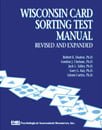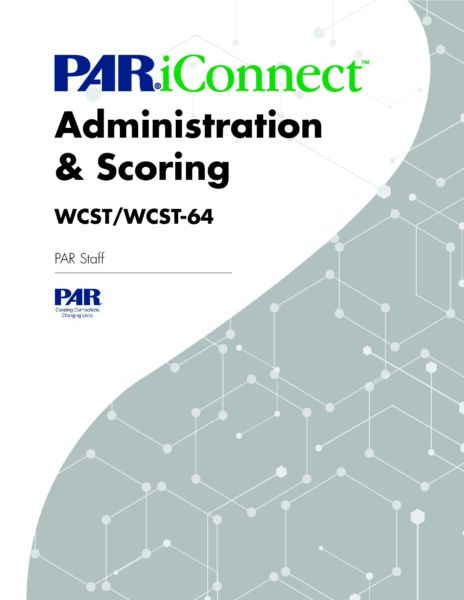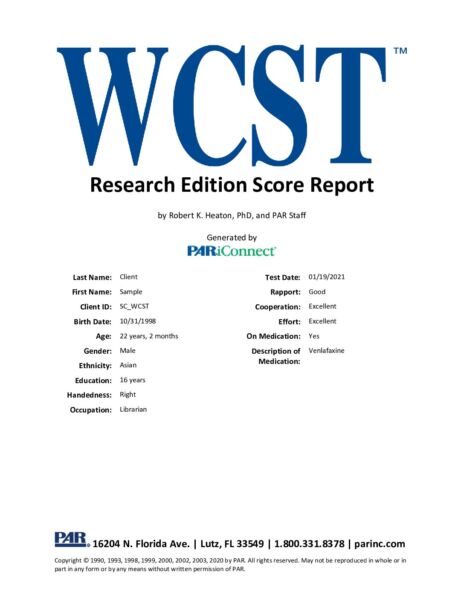
Wisconsin Card Sorting Test [WCST]
Assesses perseveration and abstract reasoning in children and adults
For Ages: 6.5 – 89 years
Format: Paper-and-Pencil; online in PARiConnect online platform
Length: 20-30 minutes
Scoring: Hand Scored; online in PARiConnect online platform
Authors: David A. Grant, PhD and Esta A. Berg, PhD; Professional Manual by Robert K. Heaton, PhD, Gordon J. Chelune, PhD, Jack L. Talley, PhD, Gary G. Kay, PhD, and Glenn Curtiss, PhD
Online Forms, Reports, Kits & e-Manuals
All online resources including Forms, Reports, i-Admins, Kits and e-Manuals.
Printed Manuals
Physical printed manuals.
Printed Forms & Handscoring Materials
Test forms, response booklets and scoring reference manuals.
Printed Kits
Click to browse products
WCST e-Manual
WCST/WCST-64 Digital Kit
WCST/WCST-64 online Score Report (each) min order 5
WCST/WCST-64 online i-Admin (each) min order 5
WCST Manual, Revised and Expanded
WCST Card Deck (Set of 2)
WCST Record Booklets (25)
WCST Introductory Kit
The WCST is used primarily to assess perseveration and abstract thinking, it is also considered a measure of executive function because of its reported sensitivity to frontal lobe dysfunction. As such, the WCST allows the clinician to assess the following “frontal” lobe functions: strategic planning, organised searching, utilising environmental feedback to shift cognitive sets, directing behaviour toward achieving a goal, and modulating impulsive responding.
Features and Benefits
- Completion of the WCST requires the ability to develop and maintain an appropriate problem-solving strategy across changing stimulus conditions in order to achieve a future goal.
- Unlike other measures of abstraction, the WCST provides objective measures of overall success and identifies particular sources of difficulty on the task (e.g., inefficient initial conceptualization, perseveration, failure to maintain a cognitive set, inefficient learning across stages of the test).
- When used with more comprehensive ability testing, the WCST is helpful in discriminating frontal from nonfrontal lesions.
Administration & Scoring
- Administration and scoring for the WCST and WCST-64 are available on PARiConnect online platform. Choose the 64- or 128-card version, or decide after administration.
- Learn how to Administer & Score WCST and WCST-64 in the Resources section of this page.
- Designed for individuals ages 6.5-89 years.
- The four stimulus cards incorporate three stimulus parameters.
- The stimulus cards and response cards use the systematic figure configurations originally developed and introduced in 1948 by David A. Grant, PhD, and Esta A. Berg, PhD.
- Raw score to normalised standard, percentile and T score conversion.
- Normative data derived from 899 normal children, adolescents and adults.
- Case illustrations aid in scoring and interpretation.
The response cards are numbered from 1 to 64 on the lower left corner of the reverse side to ensure a standard order of presentation. Respondents are required to sort the cards according to different principles during the test administration. Clients should have normal or corrected vision and hearing sufficient to adequately comprehend the test instructions and to visually discriminate the stimulus parameters of Colour, Form and Number. Among clinical populations with known or suspected brain dysfunction, these requirements may not be fully met. In such cases, the reliability and validity of the WCST data will depend on the clinical skill and expertise of the examiner.
Read more on how to Administer & Score WCST and WCST-64 in the Resources section of this page.
Training is available
This informative DVD tutorial provides detailed training in the standardized WCST administration and scoring procedures developed by Dr. Robert K. Heaton. The training package is particularly helpful for individuals who are just learning to administer this multifaceted neuropsychological instrument. It is also an excellent review for experienced clinicians and psychometricians.
Resources & Sample Reports
 NZ
NZ







